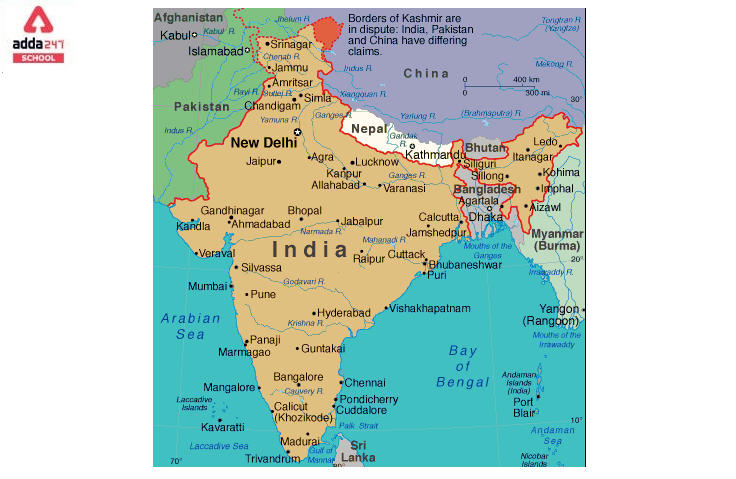Table of Contents
Why is India called a Subcontinent?
India is called a subcontinent due to its distinct geographical, geological, cultural, historical, and socio-economic characteristics that set it apart from the rest of the Asian continent. The term “subcontinent” refers to a large, separate landmass that is part of a larger continent. Here are the key reasons why India is referred to as a subcontinent:
- Geographical Boundaries: India is located in the southern region of the Asian continent and is primarily demarcated by natural features. To the north, the majestic Himalayas act as a natural barrier, separating India from the rest of Asia. This geographical isolation contributes to India’s classification as a subcontinent.
- Vast Size and Diverse Landscapes: India’s vast size justifies its status as a subcontinent. With an area of approximately 3.29 million square kilometers, India is the seventh-largest country globally. Within this expansive territory, it encompasses a remarkable range of landscapes, including towering mountain ranges, fertile plains, arid deserts, coastal regions, and lush rainforests. Such geographical diversity is unique to India and strengthens its classification as a subcontinent.
- Geological Evolution: India’s geological history also plays a significant role in labeling it as a subcontinent. The Indian subcontinent was once a separate landmass known as Gondwana, which later collided with the Eurasian plate. This collision formed the Himalayan mountain range and resulted in the unique geological formations found in the region. The distinctiveness of India’s geological evolution further supports its classification as a subcontinent.
- Cultural and Ethnic Diversity: India’s cultural and ethnic diversity is unparalleled, making it a subcontinent in terms of sociocultural dimensions. The Indian subcontinent is home to a multitude of religions, languages, traditions, and lifestyles. It is a melting pot of cultures, with a history that spans thousands of years. The coexistence of various religions such as Hinduism, Islam, Sikhism, Buddhism, and Christianity, among others, contributes to the subcontinental identity of India.
- Historical Significance: India’s rich historical legacy adds another layer to its subcontinental classification. The Indian subcontinent has been the cradle of ancient civilizations, including the Indus Valley Civilization, which flourished around 2500 BCE. The region has witnessed the rise and fall of numerous empires, the advent of influential philosophies, and the birth of great thinkers and scholars. These historical aspects solidify India’s stature as a subcontinent.
- Political and Economic Influence: India’s position as a subcontinent is also influenced by its political and economic significance. As one of the world’s fastest-growing economies and the second-most populous country, India wields considerable influence in regional and global affairs. Its geopolitical importance, combined with its vast and diverse resources, positions India as a subcontinent of immense political and economic consequence.
India is called a subcontinent due to its unique geographical boundaries, vast size and diverse landscapes, distinctive geological evolution, cultural and ethnic diversity, historical significance, and political and economic influence. These factors collectively contribute to India’s characterization as a subcontinent within the Asian continent.
Why is India called Subcontinent?
Let’s first have a look at what a subcontinent is.
- A large piece of land that is self-contained and forms a division is known as the subcontinent.
- Asia is a continent, where India is situated. India is a small part of the entire Asia. This is also another reason why India is called a subcontinent.
Now as we know what a subcontinent is, it will be easier to understand why India is called a subcontinent.
Why is India called a Subcontinent Short Answer for Class 9?
As India is a governed, separate piece of land, which is apart from the continent and appears to be a part of the main continent, India is known as a subcontinent.
Historically, India used to be a continent. Later due to the continuous movement of land, and continental drift, it became a part of Asia.
Any piece of land which is large and independent politically can be called a subcontinent.
Why India is called Subcontinent?: Countries that form a part of the Indian Subcontinent
The countries which form a part of the Indian subcontinent are
- Bhutan
- Pakistan
- Bangladesh
- Nepal
- Maldives
- Sri-Lanka
- India
India is also a peninsular region as it is surrounded by oceans on three sides.
why india is called subcontinent reasons?
India, a land of rich culture, diverse landscapes, and storied history, is often referred to as a subcontinent. This appellation stems from various geographic, geological, and cultural factors that distinguish India from the rest of the Asian continent. All valid reasons are mentioned in the above article.


 NEET Crash Course 2025, Check the Best N...
NEET Crash Course 2025, Check the Best N...
 CBSE Latest News 2025- No Change in Boar...
CBSE Latest News 2025- No Change in Boar...
 Delhi Nursery Admission 2025-26 Dates Ou...
Delhi Nursery Admission 2025-26 Dates Ou...






























